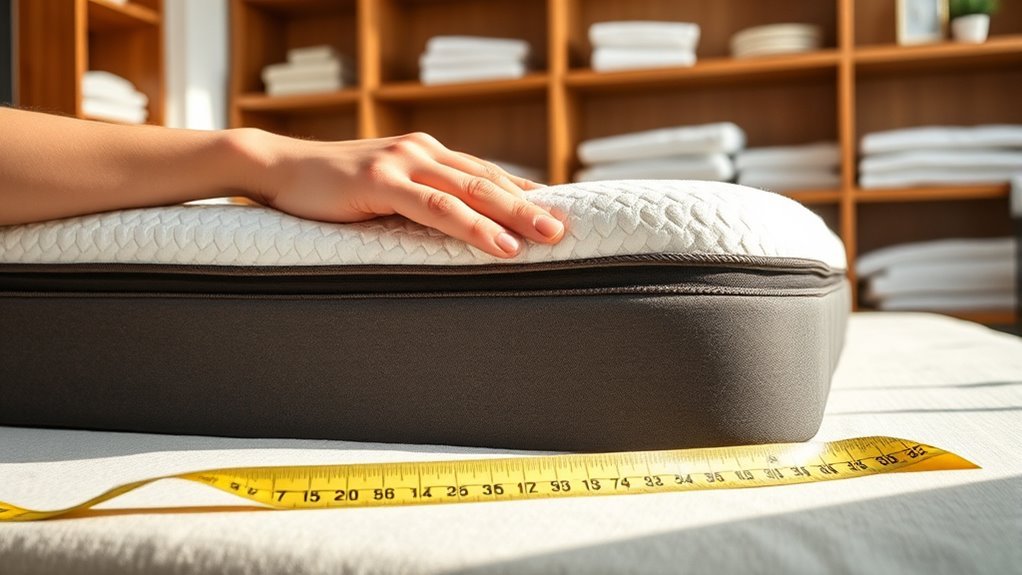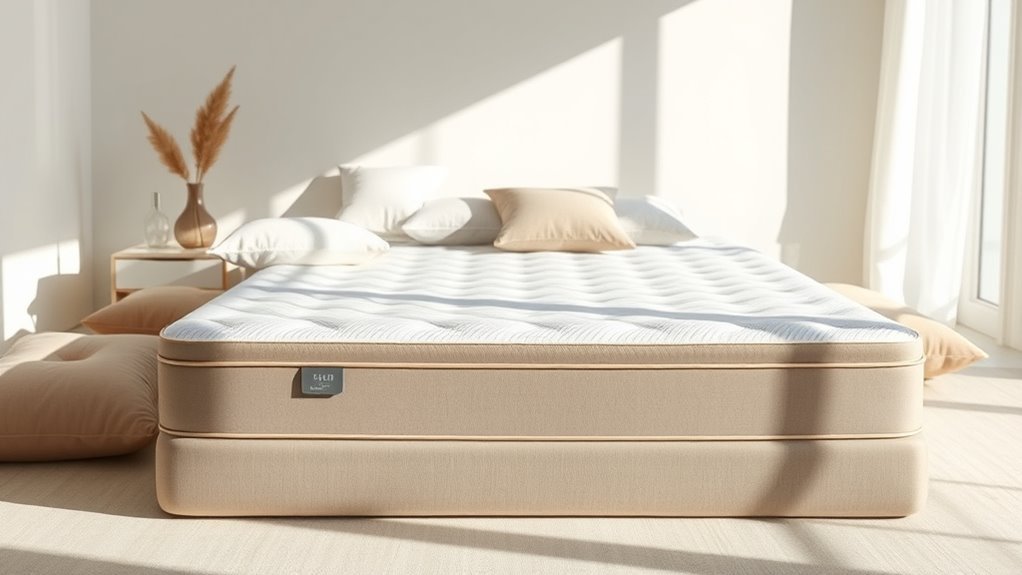Selecting a firm mattress for back pain relief involves understanding firmness levels and ensuring proper spinal alignment. Look for materials like high-quality latex or memory foam that provide durability and targeted support. Contemplate your sleeping position; side sleepers might benefit from a medium-firm mattress, while back sleepers may prefer a firmer surface. Don’t forget to test the mattress for comfort and thickness before committing. Discover more aspects to ponder in your search for the perfect mattress.
Understanding Firmness Levels

When you’re considering a mattress for back pain relief, understanding firmness levels is essential to finding the right support. Firmness ratings typically range from soft to extra firm, impacting how the mattress feels under your body. A firmer mattress often provides better support for your spine, helping to maintain proper alignment, which is vital in alleviating back pain. However, personal preference plays a significant role; some may prefer a slightly softer feel that contours to their body while still offering adequate support. Testing various firmness levels in-store or utilizing online tools can help you determine what suits your needs best. Ultimately, the right balance between firmness and comfort can lead to a more restful night’s sleep and improved overall well-being.
Importance of Support for Spinal Alignment

When choosing a mattress, support for spinal alignment is essential for your overall health and comfort. A firm mattress can help distribute your body weight evenly, reducing pressure points that may lead to discomfort. Additionally, your sleep position plays a significant role in determining the level of support you need for maintaining proper spinal alignment.
Role of Firmness
While many factors contribute to back pain, the firmness of your mattress plays an essential role in supporting proper spinal alignment. A firm mattress can help maintain the natural curvature of your spine, reducing strain on muscles and ligaments. It’s important to understand firmness myths; many believe that a firmer mattress is always better, but personal preferences and body types greatly influence what’s best for you. If you’re heavier, a firmer mattress may provide the necessary support, while lighter individuals might benefit from a slightly softer surface. Ultimately, your choice should prioritize spinal alignment while considering your unique comfort needs. Finding the right balance will help you achieve restful sleep and alleviate back pain effectively.
Pressure Point Distribution
A firm mattress not only aids in maintaining spinal alignment but also plays an essential role in pressure point distribution. When you’re choosing a mattress, consider how it will support your body and guarantee even weight distribution. Proper support can alleviate discomfort by reducing pressure on sensitive areas. Here are some key aspects to keep in mind:
- Provides balanced support for your spine
- Reduces strain on pressure points like shoulders and hips
- Enhances circulation through better weight distribution
- Minimizes the risk of waking up with aches
- Promotes a restful sleep environment
Sleep Position Considerations
Choosing the right mattress can greatly impact your sleep position and overall spinal alignment, especially if you suffer from back pain. Your sleeping habits play an essential role in how your body is supported throughout the night. For side sleepers, a medium-firm mattress can relieve pressure on the hips and shoulders while maintaining spinal alignment. Back sleepers, on the other hand, need firmer support to keep the spine neutral. Stomach sleepers often require a firmer surface to prevent the lower back from sinking. Consider making mattress adjustments based on your sleep position to optimize comfort and support. Ultimately, selecting the right firmness can help alleviate pain and enhance your overall quality of sleep, allowing you the freedom to wake up refreshed.
Evaluating Mattress Materials

When selecting a mattress, the materials used can notably impact your comfort and support. Different types of materials offer varying levels of firmness and durability, which can affect how well your mattress alleviates back pain. Understanding these factors will help you make an informed decision tailored to your specific needs.
Types of Mattress Materials
While selecting the right mattress material can seem overwhelming, understanding the various options available can greatly influence your comfort and back pain relief. Here are some popular materials to evaluate:
- Latex Mattresses: Known for their durability and support, they can help maintain spinal alignment.
- Memory Foam: Offers contouring support, reducing pressure points but may retain heat.
- Innerspring: Provides a traditional feel with support from coils, often allowing for good airflow.
- Hybrid: Combines foam and innerspring, offering both support and comfort.
- Organic Materials: Made from natural fibers, these are great for those seeking eco-friendly options without harmful chemicals.
Choosing the right material tailored to your needs can greatly enhance your sleep experience and alleviate back pain.
Firmness vs. Support
Understanding the difference between firmness and support is essential for finding a mattress that effectively alleviates back pain. Many people fall prey to firmness misconceptions, believing that a harder surface will always provide better support. However, true support comes from a mattress’s ability to maintain spinal alignment and adapt to your body’s contours. A mattress can be firm yet fail to offer adequate support if it doesn’t relieve pressure points. Look for materials like high-density foam or innerspring systems that balance firmness and support importance. Testing various mattresses will help you identify the right combination that enables freedom of movement while ensuring your spine’s alignment, so you wake up pain-free and refreshed.
Durability and Longevity
Choosing a mattress isn’t just about comfort; it’s also about ensuring it lasts. A mattress’s lifespan heavily depends on the material quality. Investing in high-quality materials can save you money and improve your sleep over time. Here are some key considerations:
- Foam Density: Higher density foams typically offer better durability.
- Innerspring Gauge: Thicker coils often provide more support and longevity.
- Natural Materials: Latex and organic fibers may outlast synthetic options.
- Warranty Terms: A longer warranty usually indicates manufacturer confidence in durability.
- User Reviews: Real-life experiences can provide insights into longevity.
Benefits of Memory Foam for Back Pain
When it comes to alleviating back pain, memory foam mattresses offer several advantages that can greatly improve your sleep quality. One of the key memory foam advantages is its ability to contour to your body, providing targeted support where you need it most. This adaptive quality helps distribute your weight evenly, reducing pressure points that can lead to discomfort. As a result, you’ll experience enhanced pressure relief, which is essential for those suffering from chronic back pain. Additionally, memory foam’s motion isolation properties guarantee that movements from a partner won’t disrupt your sleep. Ultimately, choosing a memory foam mattress may not only relieve your back pain but also promote a restful night’s sleep, allowing you to wake up refreshed and ready for the day.
The Role of Innerspring Mattresses
While memory foam is popular for back pain relief, innerspring mattresses also play a notable role in providing support and comfort. They offer unique innerspring benefits, making them a viable option for many individuals. Here’s what you should know:
Innerspring mattresses offer valuable support and comfort, making them a strong contender for back pain relief.
- Variety of coil types: Innerspring mattresses come in different coil types, such as pocketed coils and continuous coils, each providing varying levels of support.
- Enhanced airflow: The open structure allows for better airflow, keeping you cooler during sleep.
- Durability: High-quality innerspring mattresses can offer long-lasting support.
- Firmness options: You can find models that cater to your preferred firmness level.
- Responsive support: They provide immediate bounce and responsiveness, helping maintain spinal alignment.
Choosing the right innerspring mattress can notably impact your back pain relief journey.
Hybrid Mattresses: A Balanced Approach
Hybrid mattresses combine the supportive features of innerspring coils with the contouring comfort of foam, making them an appealing choice for those seeking relief from back pain. The mattress construction typically features a base of coils for ideal support and a comfort layer of memory or latex foam to cradle your body. This combination allows for better spinal alignment, which is essential for alleviating discomfort. One of the notable hybrid benefits is their ability to cater to various sleep positions, accommodating side, back, and stomach sleepers alike. In addition, hybrids often have improved breathability, preventing overheating during the night. For many, this balance between support and comfort can lead to a more restful, pain-free sleep experience.
Choosing the Right Thickness
Choosing the right thickness for your mattress can greatly impact your back pain relief. When considering thickness options, it’s essential to find a balance that supports your body while maintaining comfort. Here are some factors to help you decide:
- Mattress height: Typically ranges from 8 to 14 inches; choose according to your bed frame and personal preference.
- Sleep position: Side sleepers may prefer thicker mattresses for cushioning, while back and stomach sleepers might benefit from firmer, thinner options.
- Body weight: Heavier individuals often require more support, suggesting a thicker mattress.
- Material type: Different materials provide varying levels of support and comfort at different thicknesses.
- Personal preference: Ultimately, your comfort should guide your choice in thickness options.
Testing the Mattress: What to Look For
How can you guarantee that the mattress you’re considering will truly alleviate your back pain? Start with mattress testing to see how it feels under your body weight. Lie down for at least 10-15 minutes in your usual sleeping position. Pay attention to how your spine aligns; it should maintain a natural curve without excessive sinking. Consider your firmness preferences; a mattress that’s too soft may exacerbate pain, while one that’s too firm can be uncomfortable. Look for materials that offer support without compromising comfort, such as high-density foam or innerspring systems. Remember, it’s essential to test multiple options to find the perfect balance between support and comfort tailored to your unique needs.
Considering Your Sleeping Position
When selecting a firm mattress, your sleeping position plays an essential role in ensuring comfort and support. Side sleepers often require more cushioning to accommodate their shoulders and hips, while back sleepers typically benefit from a firmer surface that maintains spinal alignment. Understanding these distinct needs can help you make an informed choice for back pain relief.
Side Sleepers’ Needs
Many side sleepers find that their mattress choice considerably impacts their comfort and spinal alignment. Choosing the right firm mattress can alleviate pressure points and support your body’s natural curvature. Here are some essential factors to evaluate:
- Mattress types: Memory foam and latex are often recommended for side sleepers due to their contouring properties.
- Firmness level: A medium-firm mattress typically strikes the right balance between support and comfort.
- Sleeping accessories: Pillows that support your neck can enhance spinal alignment.
- Pressure relief: Look for materials that distribute weight evenly to reduce discomfort.
- Trial periods: Opt for brands that offer trial periods to test comfort before committing.
Back Sleepers’ Preferences
While back sleepers often prioritize spinal alignment, their mattress choice plays a crucial role in ensuring comfort and support throughout the night. Your back sleeper preferences likely lean towards a medium-firm to firm mattress, as this level of mattress firmness helps maintain the natural curve of your spine. A mattress that’s too soft can lead to sinkage, causing misalignment and discomfort. Research indicates that a firmer surface promotes better posture and reduces pressure on the lower back. When selecting a mattress, look for one that provides adequate support while still allowing some contouring for your body’s shape. This balance can enhance your sleep quality and alleviate back pain, giving you the freedom to wake up refreshed and ready for the day.
Warranty and Return Policies
Understanding warranty and return policies is essential, especially since investing in a firm mattress for back pain relief can be a significant financial commitment. Familiarizing yourself with the warranty options and return procedures can save you from future headaches. Here are some key points to reflect upon:
- Length of warranty: Check how long the coverage lasts.
- Types of defects covered: Know what issues are included.
- Return window: Understand how long you have to return the mattress if needed.
- Shipping costs: Be aware of who pays for return shipping.
- Trial period: Look for a risk-free trial to test the mattress.
Frequently Asked Questions
How Often Should I Replace My Firm Mattress?
You should replace your firm mattress every 7 to 10 years, as this is its typical lifespan. Pay attention to replacement signs like sagging, lumps, or a decline in comfort and support. If you’re waking up with aches or feeling unrested, it’s time to take into account a new mattress. Regularly evaluating its condition guarantees you maintain ideal sleep quality, which is essential for your overall health and well-being.
Can a Firm Mattress Worsen Existing Back Pain?
Yes, a firm mattress can worsen existing back pain if it doesn’t match your body’s needs. You might think firmness equals support, but if it’s too hard, it can create pressure points, disrupting your mattress comfort. Pain management relies on finding the right balance—too much firmness can lead to discomfort and exacerbate your pain. Always consider how your body feels and don’t hesitate to explore options that promote better spinal alignment and comfort.
What Is the Ideal Firmness Level for Side Sleepers?
The ideal firmness level for side sleepers typically ranges from medium to medium-firm. This provides the necessary mattress support while ensuring pressure relief at the shoulders and hips. A mattress that’s too firm can lead to discomfort, while one that’s too soft might not offer adequate support, causing misalignment. Look for a balance that contours to your body shape, allowing you to sleep comfortably without waking up with pain.
Are There Specific Brands Known for Back Pain Relief?
Yes, there are specific brands known for back pain relief. Sealy Posturepedic mattresses are designed with targeted support for your back, helping to maintain proper spinal alignment. Tempur Pedic, on the other hand, uses memory foam that conforms to your body, providing personalized comfort and pressure relief. Both brands have received positive feedback from users seeking relief from back pain, so you might want to take them into account when making your choice.
How Do I Properly Care for a Firm Mattress?
Caring for a firm mattress is like tending a garden; with the right attention, it flourishes. Regularly vacuum your mattress to remove dust and allergens, and spot clean stains with a mild detergent. Consider using a mattress protector to enhance temperature regulation and shield against spills. Rotate your mattress every few months to guarantee even wear. These simple steps can prolong its life, keeping you comfortable and supported for years to come.



